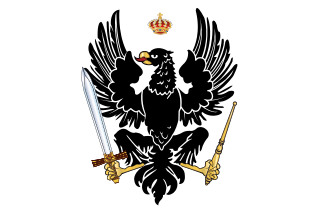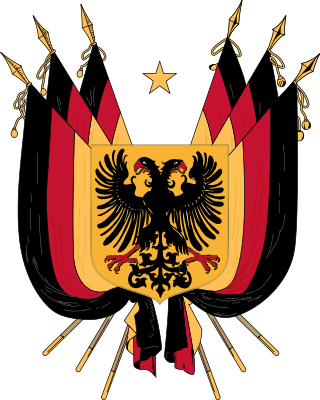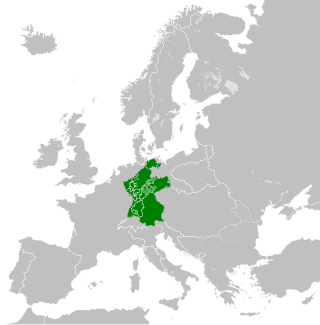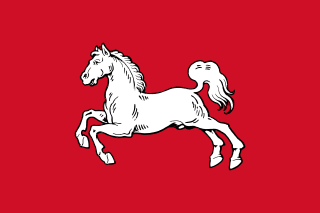
The national flag of Germany is a tricolour consisting of three equal horizontal bands displaying the national colours of Germany: black, red, and gold. The flag was first sighted in 1848 in the German Confederation. The flag was also used by the German Empire from 1848 to 1849. It was officially adopted as the national flag of the German Reich from 1919 to 1933, and has been in use since its reintroduction in Federal Republic of Germany in 1949.

The German Confederation was an association of 39 predominantly German-speaking sovereign states in Central Europe. It was created by the Congress of Vienna in 1815 as a replacement of the former Holy Roman Empire, which had been dissolved in 1806 in reaction to the Napoleonic Wars.

The Kingdom of Prussia constituted the German state of Prussia between 1701 and 1918. It was the driving force behind the unification of Germany in 1866 and was the leading state of the German Empire until its dissolution in 1918. Although it took its name from the region called Prussia, it was based in the Margraviate of Brandenburg. Its capital was Berlin.

The North German Confederation was initially a German military alliance established in August 1866 under the leadership of the Kingdom of Prussia, which was transformed in the subsequent year into a confederated state that existed from July 1867 to December 1870. A milestone of the German Unification, it was the earliest continual legal predecessor of the modern German nation-state known today as the Federal Republic of Germany.

The Frankfurt Parliament was the first freely elected parliament for all German states, including the German-populated areas of the Austrian Empire, elected on 1 May 1848.

A Landtag is generally the legislative assembly or parliament of a federated state or other subnational self-governing entity in German-speaking nations. It is usually a unicameral assembly exercising legislative competence in non-federal matters.

The Confederated States of the Rhine, simply known as the Confederation of the Rhine or Rhine Confederation, was a confederation of German client states established at the behest of Napoleon some months after he defeated Austria and Russia at the Battle of Austerlitz. Its creation brought about the dissolution of the Holy Roman Empire shortly afterward. The Confederation of the Rhine lasted for 7 years, from 1806 to 1813.

Bremen-Verden, formally the Duchies of Bremen and Verden, were two territories and immediate fiefs of the Holy Roman Empire, which emerged and gained imperial immediacy in 1180. By their original constitution they were prince-bishoprics of the Archdiocese of Bremen and Bishopric of Verden.

The Kingdom of Hanover was established in October 1814 by the Congress of Vienna, with the restoration of George III to his Hanoverian territories after the Napoleonic era. It succeeded the former Electorate of Hanover, and joined 38 other sovereign states in the German Confederation in June 1815. The kingdom was ruled by the House of Hanover, a cadet branch of the House of Welf, in personal union with Great Britain between 1714 and 1837. Since its monarch resided in London, a viceroy, usually a younger member of the British royal family, handled the administration of the Kingdom of Hanover.

The Constitution of the German Empire was the basic law of the German Empire of 1871–1918, from 16 April 1871, coming into effect on 4 May 1871. German historians often refer to it as Bismarck's imperial constitution, in German the Bismarcksche Reichsverfassung (BRV).

The German Emperor was the official title of the head of state and hereditary ruler of the German Empire. A specifically chosen term, it was introduced with the 1 January 1871 constitution and lasted until the official abdication of Wilhelm II on 9 November 1918. The Holy Roman Emperor is sometimes also called "German Emperor" when the historical context is clear, as derived from the Holy Roman Empire's official name of "Holy Roman Empire of the German Nation" from 1512.

The Electorate of Hanover was an electorate of the Holy Roman Empire, located in northwestern Germany and taking its name from the capital city of Hanover. It was formally known as the Electorate of Brunswick-Lüneburg. For most of its existence, the electorate was ruled in personal union with Great Britain and Ireland following the Hanoverian Succession.

The term Reichskriegsflagge refers to several war flags and war ensigns used by the German armed forces in history. A total of eight different designs were used in 1848–1849 and between 1867–1871 and 1945.
The term "Lesser Germany" or "Lesser German solution" denoted essentially exclusion of the multinational Austria of the Habsburgs from the planned German unification as an option for solving the German question, in opposition to the one of 'Greater Germany'.

The Reichsflotte was the first navy for all of Germany, established by the revolutionary German Empire to provide a naval force in the First Schleswig War against Denmark. The decision was made on 14 June 1848 by the Frankfurt Parliament, which is considered by the modern German Navy as its birthday.
The Stade Region emerged in 1823 by an administrative reorganisation of the dominions of the Kingdom of Hanover, a sovereign state, whose then territory is almost completely part of today's German federal state of Lower Saxony. Until 1837 the Kingdom of Hanover was ruled in personal union by the Kings of the United Kingdom of Great Britain and Ireland.

The German Empire consisted of 25 constituent states and an imperial territory, the largest of which was Prussia. These states, or Staaten each had votes in the Bundesrat, which gave them representation at a federal level.

The German Empire was a proto-state which attempted, but ultimately failed, to unify the German states within the German Confederation to create a German nation-state. It was created in the spring of 1848 during the German revolutions by the Frankfurt National Assembly. The parliament elected Archduke John of Austria as its provisional head of state with the title 'Imperial Regent'. On 28 March 1849, its constitution was implemented and the parliament elected the king of Prussia, Frederick William IV, to be the constitutional monarch of the empire with the title 'Emperor of the Germans'. However, he turned the position down. The empire came to an end in December 1849 when the Central German Government was replaced by a Federal Central Commission.
The North German Confederation Treaty was the treaty between the Kingdom of Prussia and other northern and central German states that initially created the North German Confederation, which was the forerunner to the German Empire. This treaty, and others that followed in September and October, are often described as the August treaties, although not all of them were concluded in August 1866.
The term federal execution, or refers to the right of a confederation or federation to act militarily against individual member states if they violate duties resulting from membership. The term "Reichsexekution" is also used in Germany depending on the respective state name.















